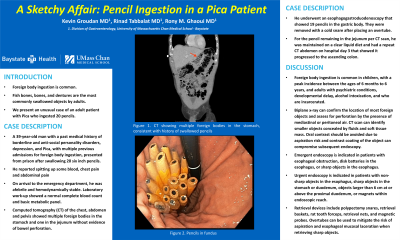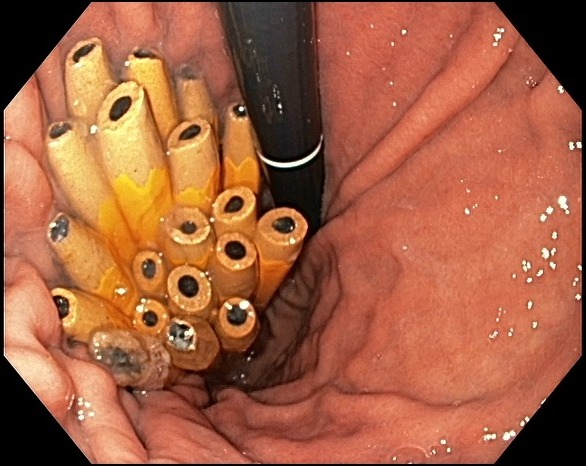Tuesday Poster Session
Category: General Endoscopy
P3439 - A Sketchy Affair: Pencil Ingestion in a Pica Patient
Tuesday, October 24, 2023
10:30 AM - 4:00 PM PT
Location: Exhibit Hall

Has Audio
- KG
Kevin Groudan, MD
University of Massachusetts Chan Medical School-Baystate
Springfield, MA
Presenting Author(s)
Kevin Groudan, MD, Rinad Tabbalat, MD, Rony Ghaoui, MD
University of Massachusetts Chan Medical School-Baystate, Springfield, MA
Introduction: Foreign body ingestion is a common occurrence. Fish bones, bones, and dentures are the most commonly swallowed objects by adults. We present an unusual case of an adult patient with Pica who ingested 20 pencils.
Case Description/Methods: A 39-year-old man with a past medical history of borderline and anti-social personality disorders, depression, and Pica with multiple previous admissions for foreign body ingestion presented from prison after swallowing 20 6 inch pencils. He reported spitting up some blood, chest pain and abdominal pain but denied any nausea or vomiting. On arrival to the emergency department, he was afebrile and hemodynamically stable. Laboratory work-up showed a normal complete blood count and basic metabolic panel. Computed tomography (CT) of the chest, abdomen and pelvis showed multiple foreign bodies in the stomach and one in the jejunum without evidence of bowel perforation. He underwent an esophagogastroduodenoscopy that showed 19 pencils in the gastric body. They were removed with a cold snare after placing an overtube. For the pencil remaining in the jejunum per CT scan, he was maintained on a clear liquid diet and had a repeat CT abdomen on hospital day 3 that showed it progressed to the ascending colon. He left against medical advice on hospital day 4.
Discussion: Foreign body ingestion is common in children, with a peak incidence between the ages of 6 months to 6 years, and adults with psychiatric conditions, developmental delay, alcohol intoxication, and who are incarcerated. Biplane x-ray can confirm the location of most foreign objects and assess for perforation by the presence of mediastinal or peritoneal air. CT scan is useful for identifying smaller objects concealed by fluids and soft tissue mass. Oral contrast should generally be avoided due to aspiration risk and contrast coating of the object can compromise subsequent endoscopy. Foreign body removal by emergent endoscopy is indicated in patients with esophageal obstruction, disk batteries in the esophagus, or sharp objects in the esophagus. Urgent endoscopy is indicated in patients with non-sharp objects in the esophagus, sharp objects in the stomach or duodenum, objects larger than 6 cm at or above the proximal duodenum, or magnets within endoscopic reach. Retrieval devices include polypectomy snares, retrieval baskets, rat tooth forceps, retrieval nets, and magnetic probes. Overtubes can be used to mitigate the risk of aspiration and esophageal mucosal laceration when retrieving sharp objects.

Disclosures:
Kevin Groudan, MD, Rinad Tabbalat, MD, Rony Ghaoui, MD. P3439 - A Sketchy Affair: Pencil Ingestion in a Pica Patient, ACG 2023 Annual Scientific Meeting Abstracts. Vancouver, BC, Canada: American College of Gastroenterology.
University of Massachusetts Chan Medical School-Baystate, Springfield, MA
Introduction: Foreign body ingestion is a common occurrence. Fish bones, bones, and dentures are the most commonly swallowed objects by adults. We present an unusual case of an adult patient with Pica who ingested 20 pencils.
Case Description/Methods: A 39-year-old man with a past medical history of borderline and anti-social personality disorders, depression, and Pica with multiple previous admissions for foreign body ingestion presented from prison after swallowing 20 6 inch pencils. He reported spitting up some blood, chest pain and abdominal pain but denied any nausea or vomiting. On arrival to the emergency department, he was afebrile and hemodynamically stable. Laboratory work-up showed a normal complete blood count and basic metabolic panel. Computed tomography (CT) of the chest, abdomen and pelvis showed multiple foreign bodies in the stomach and one in the jejunum without evidence of bowel perforation. He underwent an esophagogastroduodenoscopy that showed 19 pencils in the gastric body. They were removed with a cold snare after placing an overtube. For the pencil remaining in the jejunum per CT scan, he was maintained on a clear liquid diet and had a repeat CT abdomen on hospital day 3 that showed it progressed to the ascending colon. He left against medical advice on hospital day 4.
Discussion: Foreign body ingestion is common in children, with a peak incidence between the ages of 6 months to 6 years, and adults with psychiatric conditions, developmental delay, alcohol intoxication, and who are incarcerated. Biplane x-ray can confirm the location of most foreign objects and assess for perforation by the presence of mediastinal or peritoneal air. CT scan is useful for identifying smaller objects concealed by fluids and soft tissue mass. Oral contrast should generally be avoided due to aspiration risk and contrast coating of the object can compromise subsequent endoscopy. Foreign body removal by emergent endoscopy is indicated in patients with esophageal obstruction, disk batteries in the esophagus, or sharp objects in the esophagus. Urgent endoscopy is indicated in patients with non-sharp objects in the esophagus, sharp objects in the stomach or duodenum, objects larger than 6 cm at or above the proximal duodenum, or magnets within endoscopic reach. Retrieval devices include polypectomy snares, retrieval baskets, rat tooth forceps, retrieval nets, and magnetic probes. Overtubes can be used to mitigate the risk of aspiration and esophageal mucosal laceration when retrieving sharp objects.

Figure: Esophagogastroduodenoscopy showed 19 pencils in the gastric body.
Disclosures:
Kevin Groudan indicated no relevant financial relationships.
Rinad Tabbalat indicated no relevant financial relationships.
Rony Ghaoui indicated no relevant financial relationships.
Kevin Groudan, MD, Rinad Tabbalat, MD, Rony Ghaoui, MD. P3439 - A Sketchy Affair: Pencil Ingestion in a Pica Patient, ACG 2023 Annual Scientific Meeting Abstracts. Vancouver, BC, Canada: American College of Gastroenterology.
